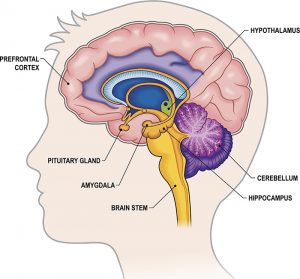
Focus Area 7: At-Risk Behaviors
1. Understanding Adolescent Risk-Taking
Let’s start with a high-level overview of adolescent risk-taking to understand what drives these behaviors.
Risk-taking - no matter an individual’s age - is a natural and normal part of human development. It enables us to learn new skills and prepare for future challenges. For adolescents, risk-taking is a means to discover, test, and define oneself, as well as others and the larger world. Risk-taking is actually an essential part of adolescent development.
Youth workers are likely to have concerns about risky behaviors in youth at any age but there is a greater cause for concern about patterns of risky behavior in adolescents. This is because adolescence is a time of both great potential and great vulnerability. The stakes are typically higher with risk behaviors during adolescence.
Adolescents are at the peak of their physical strength, resilience, and immune function. However, mortality rates for 15 to 24-year olds are more than triple the mortality rates of grade school children.
These three categories of risky behaviors are associated with the leading causes of death and illness in adolescents1:
- Injury and Violence: This is the leading cause of death for adolescents and young adults between 15 - 24 years of age. These deaths are most often a result of motor vehicle crashes (30%); followed by homicides (15%) and suicides (12%).
- Alcohol and Drug Use: These substances are a factor in approximately 41% of deaths related to motor vehicle crashes. More youth in the United States use alcohol than tobacco or other drugs.
- Risky Sexual Behaviors: These behaviors lead to increased morbidity and mortality. Almost half of the 19 million sexually transmitted infections diagnosed each year in the United States are in adolescents and young adults between 15 - 24 years old. Additionally, 39% of sexually active high school students report not using a condom during their last sexual intercourse.
BRAIN DEVELOPMENT & ADOLESCENT RISK-TAKING
To help you better understand adolescent risk-taking, let’s take a look at the biological basis for risk-taking and why adolescents take risks even while knowing there are inherent dangers or consequences. Knowing the biological basis for behaviors will assist you in developing effective interventions.2
We’re not going to go into a deep study of human brain development here but it is helpful to have at least a basic understanding. We have a short, 5-minute video by Dr. Ken Winters, Director of the Center for Adolescent Substance Abuse Research at the University of Minnesota.
In the video, Dr. Winters lays out the fundamentals and introduces you to the appropriate terminology about brain development without being overly-academic about it.
You’ll find it easy to understand and you’ll most likely be able to relate to the examples shown.
Subsequent sections build upon information presented in the video so please take the time to watch the video now before moving on. Plus, it’s a nice break from reading!



RISK PERCEPTION
Developmental psychologists have measured and documented a jump in cognitive capabilities in early adolescence.3 For example:
- Beginning around 12 years of age, adolescents decrease their reliance on concrete, here-and-now thinking and begin to show the capacity for abstract thinking, visualization of potential outcomes and a logistical understanding of cause and effect.
- Adolescents begin deciding whether a given situation is safe, risky, or dangerous.
- By 15 years of age, adolescents are capable of reasoning about the possible harm or benefits of different courses of action in hypothetical situations.
These aspects of development correlate with the maturation of the frontal lobe, a shift from expanding neural connections to pruning of the connections and an increase in hormones released. All three drive an adolescent’s mood and impulsive behavior.
Studies also show there is little difference in decision-making about hypothetical situations between adults and adolescents by 15 years of age.4 However, in the real world, adolescents still engage in dangerous behaviors despite understanding the risks involved. Why is this?
To answer that question, the role of emotions and the connection between feelings and thinking need to be considered when trying to understand the way adolescents make decisions. Researchers have termed this type of thinking as “hot” cognition and “cold” cognition.
- “Hot” cognition: Thinking under conditions of high arousal and intense emotion. Under these conditions, teens tend to make poorer decisions.
- “Cold” cognition: Circumstances are less intense and teens can make better decisions.
In addition to thinking, the teen is also having multiple complex feelings such as fear of rejection, wanting to look “cool,” the excitement of the risk, or the anxiety about being caught. It becomes even more difficult for them to think through potential outcomes, understand the consequences of their decisions, or even use common sense.5
Research examining the amygdala portion of the brain and immature connections between the limbic system and the prefrontal cortex support this theory.
As a youth worker, you can be a mentor and role model to teens in your program by modeling how to control one’s emotions and make healthier decisions. You can also coach young people to develop these skills in their daily lives.
SENSATION SEEKING
The nucleus accumbens, located in the brain’s limbic system, is the area that processes information related to motivation and reward. Brain imaging studies conducted by the National Institute on Drug Abuse have shown that the nucleus accumbens is highly sensitized in adolescents and sends out strong impulses to act when faced with the opportunity to obtain something desirable.6

Full color cross-section side view of child's brain with labels
During puberty, increases in the hormones estrogen and testosterone bind receptors in the limbic system. This not only stimulates an adolescent’s sex drive, but also increases emotional volatility and impulsivity.
Addiction researchers7 have also discovered that during puberty there are changes in the brain’s reward sensitivity. These changes are related to a decrease of dopamine, which is a neurotransmitter that has multiple functions including producing feelings of pleasure.
Due to these various changes, adolescents may require higher levels of stimulation to achieve the same levels of pleasure/reward that they previously experienced. This may lead them to seek out new experiences and make riskier decisions.
According to the Center for Substance Abuse Prevention (CSAP), “Adolescents are more vulnerable than any other age group to developing nicotine, alcohol, and other drug additions because the regions of the brain that govern impulse and motivation are not yet fully formed.”8
SELF-REGULATION
Psychologists describe self-regulation as the management of emotions and motivation.
It also involves directing and controlling behavior to meet the challenges of the environment and work toward a conscious purpose.
Additionally, self-regulation encompasses “affect regulation” which relates to controlling the expression of intense emotions, impulse control and delaying gratification.9
Self-regulation requires a higher level of cognitive and executive functions. These functions reside in the prefrontal cortex, which matures independently of puberty and is still developing well into an individual’s mid-twenties.
As adolescents progress toward adulthood with bodies that are almost mature, the self-regulatory parts of their brains are still developing. An earlier onset of puberty increases the window of vulnerability, making them more susceptible to taking unhealthy risks over a longer period of time.10
During this period of development, adolescents should be allowed to make mistakes, learn from their experiences, and practice self-regulation. They should not be over-protected. Parents and youth workers can help by listening, offering support, and guidance.
SOCIAL CONTEXT OF ADOLESCENT RISK-TAKING
When looking at adolescent social development, it’s important to consider environmental factors such as relationships with peers and other social influences.
Peer Influences
An important part of adolescent development is peer influence. During adolescence, friendships develop that are more intimate and longer lasting than earlier friendships. At the same time, adolescents develop friendships with multiple groups similar in demographics or shared interests.
These friendships allow adolescents to develop their identities and define themselves independently of their parents. These friendships also help adolescents feel accepted and provide an opportunity to practice social skills. Healthy friendships provide support and positive experiences as teens encounter challenges during these years of intense change.
However, peer influence can also adversely influence unhealthy risk-taking. Psychologist Laurence Steinberg of Temple University has conducted significant research on peer influence and risk-taking in teens. In one study, using a driving simulation game, Steinberg found that when teens were playing alone they made safer decisions (e.g. not running a yellow light), but made riskier decisions in the presence of friends.11
Due to an immature prefrontal cortex, when teens find themselves in emotionally arousing situations, “hot” cognition comes into play. Adding in peer influence, adolescents are more likely to take reckless actions and make impulsive decisions in “hot” cognition.12
Societal Influences
Societal influences include mass media, community norms, and role models. Each can influence risk-taking behaviors. Societal influences can make it difficult even for adults to resist some unhealthy behaviors. Think how much harder it must be for adolescents whose judgment and decision-making skills are still developing!
Through mass media, adolescents are constantly bombarded with emotionally arousing and often dangerous messages (e.g. unprotected sex, substance abuse, alcohol use).
Neighborhoods and communities also provide adolescents with opportunities to engage in risky behaviors. Legal ordinances that allow access and community norms that foster acceptability are two examples (e.g. the legal age to purchase cigarettes, drive a car, and have access to guns).13
The value of the trusting relationship that you have with youth through your role as a youth worker is that you can be an especially important role model.
The youth you work with have learned to trust you and they likely look up to you and know they can count on your good guidance. This makes you a reliable source of support to adolescents in particular.
You’ll also be playing a role in making your community a safer, healthier, more teen-friendly environment. And your excellent role modeling of positive interaction with teens in the community could help other adults follow your lead.
Adolescent brain development research should give you a good framework for understanding risk-taking behavior and you may also find yourself wondering, “So now what? How am I supposed to get through to an adolescent who is engaging in unhealthy behaviors if it is biologically determined?”
Good question! The information on adolescent brain development research is intended to provide you with new perspective and insights. The material presented will help you better understand why traditional adult responses are not always effective in helping youth avoid high-risk behaviors.
However, you must remember that while adolescent brain development research findings are important to know, those biological factors do not negate the importance of youth having support and guidance from caring adults.
Your most important role will be in recognizing and addressing unhealthy and risky behavior patterns.
Throughout this focus area you’ll explore different ways that you can help young people understand risky behaviors and increase their protective factors.
Deon Price is an author, youth life skills coach, and motivational speaker. His lived experience gives him a unique perspective on risk-taking behavior. In the video below, Deon shares a personal story about a choice he made to act on his fear as a young person. It literally may have saved his life! He encourages you to use the lesson he learned as you work with at-risk behaviors.
1 Steinberg L. Risk taking in adolescence: What changes and why? Ann NY Academy of Sciences 1021:51-58. 2004.
2 Steinberg L. Risk taking in adolescence: What changes and why? Ann NY Academy of Sciences 1021:51-58. 2004.
3 Steinberg L. Cognitive and affective development in adolescence. Trends in Cognitive Sciences 9 (2): 69 – 76. 2005.
4 Steinberg L. Cognitive and affective development in adolescence. Trends in Cognitive Sciences 9 (2): 69 – 76. 2005.
5 F. M. Benes, in C. A. Nelson and M. Luciana, eds., Handbook of Developmental Cognitive Neuroscience (Cambridge, MA: MIT Press, 2001), 79.
6 Gardner M, Steinberg L. Peer Influence on risk taking, risk preference and risky decision-making in adolescence and adulthood. Dev Psych 41: 625-635. 2005.
7 Lopez, Schwartz SJ, Prado G et al. Adolescent Neurological Development and its Implications for Adolescent Substance Abuse Prevention. J Prim Prev 29 (1): 5-35. 2008.
8 Carls, Jeanne. “New Research on Adolescent Brain Development.” Center for Substance Abuse Prevention. November 2004, Issue #1.
9 Casey BJ, Jones RM, Hare TA. The Adolescent Brain. Ann NY Acad Sci 1124: 111-126. 2008.
10 Steinberg L. Risk Taking in Adolescence: New Perspectives From Brain and Behavioral Science. Current Directions in Psychological Science 16 (2): 55 – 59. 2007.
11 Steinberg L. Risk Taking in Adolescence: New Perspectives From Brain and Behavioral Science. Current Directions in Psychological Science 16 (2): 55 – 59. 2007.
12 Steinberg L. Risk Taking in Adolescence: New Perspectives From Brain and Behavioral Science. Current Directions in Psychological Science 16 (2): 55 – 59. 2007.
13 Simpson, A. Rae (2001). Raising Teens: A Synthesis of Research and a Foundation for Action. Boston: Center for Health Communication, Harvard School of Public Health.
If you prefer to print this section of The Art & Science of Youth Work certificate course, click on the "Print Friendly" icon to select how you would like it to print. You can remove images and icons.
